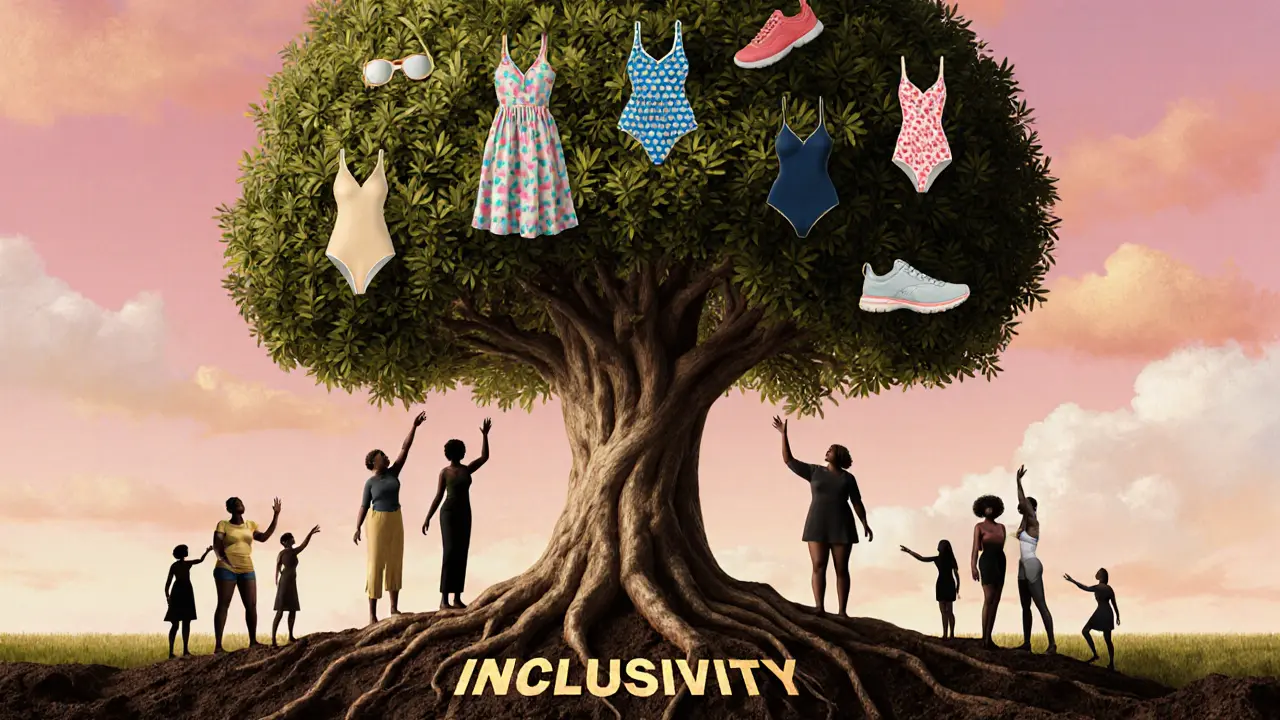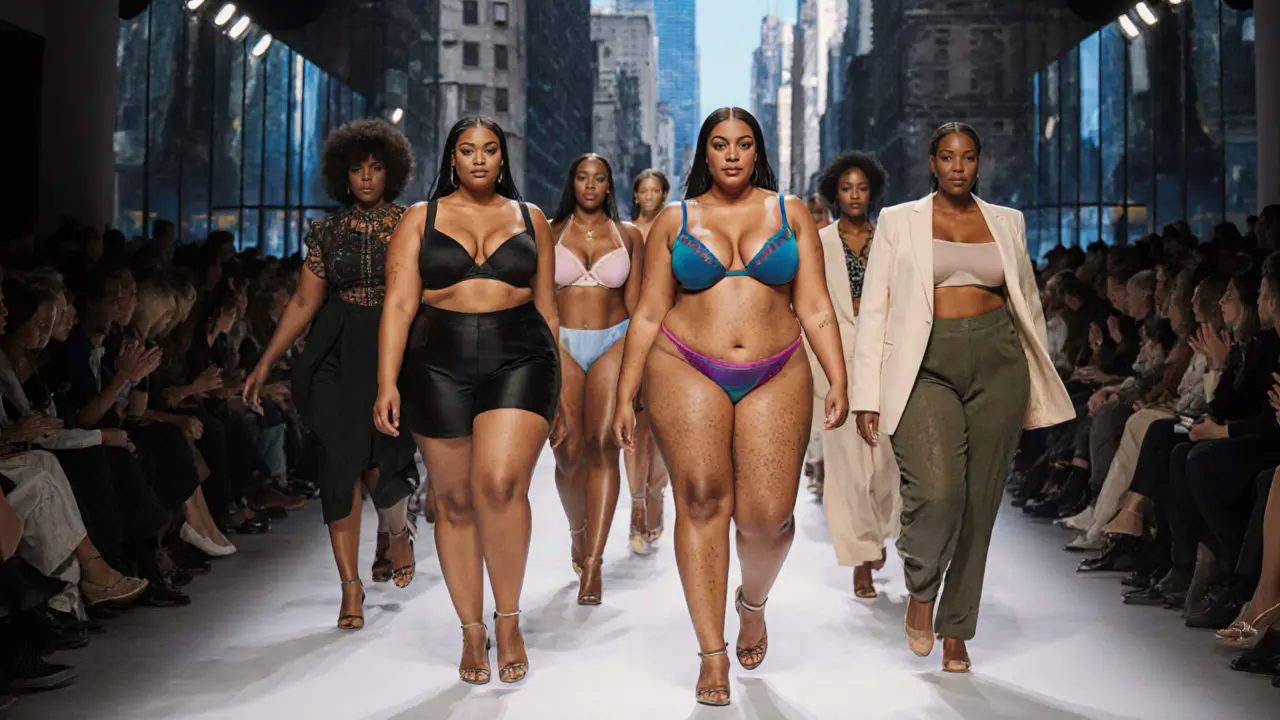Curvy Models Are Changing the Game - And It’s About Time
You’ve seen them on billboards, in magazines, walking runways in New York and Paris. They’re not just models. They’re movement. Curvy models aren’t a trend - they’re a correction. For decades, fashion told us there was only one kind of beautiful: tall, thin, and narrow. But real life doesn’t look like that. And neither do the women who’ve been pushing back - hard.
Today, curvy models aren’t fighting for a seat at the table. They’re rebuilding the whole table.
What Exactly Is a Curvy Model?
A curvy model isn’t just someone who’s ‘a little bigger’ than the average runway model. She’s typically a size 12 or above, with defined hips, a fuller bust, and natural curves that don’t fit into the old ‘sample size’ mold. But here’s the thing: it’s not just about measurements. It’s about presence. Curvy models bring confidence, energy, and authenticity that you can’t fake.
Brands like Savage X Fenty, Aerie, and Lane Bryant have led the charge by casting models with real bodies - stretch marks, cellulite, and all. These aren’t airbrushed illusions. These are women who look like your sister, your neighbor, maybe even you.
Why This Matters More Than You Think
Think about the last time you saw a model who looked like you. If it’s been a while, you’re not alone. For years, girls grew up believing their bodies were wrong because they didn’t match the ones in ads. That kind of messaging doesn’t just hurt self-esteem - it leads to eating disorders, anxiety, and a lifetime of shame.
Now, when a 16-year-old sees a curvy model in a swimsuit ad, she doesn’t just see a model. She sees permission. Permission to exist as she is. Permission to feel beautiful without shrinking herself.
Studies from the University of Cardiff found that exposure to diverse body types in media significantly improved body satisfaction in young women. That’s not just feel-good fluff. That’s mental health impact.
Where You’ll See Curvy Models Today
They’re everywhere - if you know where to look.
- Runways: Brands like Chromat, Universal Standard, and Torrid regularly feature curvy models in New York Fashion Week. In 2024, 27% of all runway models at major shows were size 12 or above - up from just 5% in 2015.
- Advertising: Target, H&M, and Nike now regularly use curvy models in national campaigns. One Nike ad featuring a curvy runner went viral in 2023, hitting 180 million views.
- Magazines: Vogue, Elle, and Harper’s Bazaar have all featured curvy covers in the last two years. In 2024, Elle’s Australian edition put a size 16 model on the cover - their first in over a decade.
- Social Media: Instagram is where the real revolution happened. Models like Ashley Graham, Lizzo, and Tess Holliday built empires not by fitting in, but by refusing to.
Meet Some of the Biggest Names in Curvy Modeling
These women didn’t wait for permission. They created the space themselves.
- Ashley Graham: The first plus-size model on the cover of Sports Illustrated Swimsuit Issue. She’s walked for Victoria’s Secret, Calvin Klein, and now runs her own lingerie line.
- Tess Holliday: A pioneer in body positivity. She turned her Instagram into a movement, proving that beauty doesn’t come with a size limit.
- Paloma Elsesser: A model with curves, freckles, and a voice. She’s walked for Chanel and Prada - brands that once ignored bodies like hers.
- Iskra Lawrence: Former model turned activist. She speaks openly about mental health and the pressure to conform - and her followers love her for it.
How the Industry Is Changing - And Where It’s Still Falling Short
Progress? Yes. Perfect? Not even close.
Most brands still use curvy models for ‘special’ collections - like ‘plus-size week’ - instead of integrating them into every campaign. And the term ‘curvy’ itself? It’s still used to separate, not include. You don’t see thin models called ‘slim models.’ They’re just ‘models.’
There’s also a lack of representation for curvy women of color, disabled curvy women, and older curvy women. The industry still treats diversity like a checklist, not a value.
But the demand is there. And consumers are voting with their wallets. Brands that ignore this are losing market share. Those that embrace it? They’re thriving.
What to Look for in a Curvy Model Agency
If you’re a curvy woman thinking about modeling, here’s what matters:
- Do they represent real bodies? Avoid agencies that only take women who look like they’re on a diet. Look for ones that list size 12+ models as their standard.
- Do they offer support? Good agencies connect you with mental health resources, nutritionists, and photographers who specialize in body-positive shoots.
- Are they transparent? No hidden fees. No pressure to lose weight. If they say ‘we’ll help you get into size 10,’ walk away.
Top agencies like Wilhelmina’s Curvy Division, Ford Models’ Plus Division, and Muse Model Management have built reputations on authenticity - not size-shaming.
Curvy Models vs. Traditional Models: The Real Difference
Here’s a simple comparison:
| Aspect | Curvy Models | Traditional Models |
|---|---|---|
| Typical Size Range | Size 12-24 (US) | Size 0-8 (US) |
| Body Type | Curvy, hourglass, pear-shaped, full bust/hips | Slender, linear, low body fat |
| Brand Focus | Lingerie, swimwear, casual wear, inclusive brands | High fashion, luxury, runway |
| Media Representation | Rising fast - 27% of 2024 runway models | Still dominant in luxury fashion |
| Public Perception | Seen as authentic, relatable, empowering | Seen as aspirational, but often unattainable |
The biggest difference? Curvy models don’t just sell clothes. They sell belonging.

What to Expect If You’re Booking a Curvy Model Shoot
If you’re a brand or photographer working with curvy models, here’s what you need to know:
- Lighting matters. Harsh shadows can exaggerate curves in unflattering ways. Soft, diffused lighting works best.
- Posing is about power, not hiding. Curvy models don’t need to cross their legs or turn sideways to ‘look smaller.’ They own their space.
- Wardrobe is key. Clothes should fit well - not too tight, not too loose. Tailoring makes all the difference.
- Respect boundaries. No comments about weight. No ‘before and after’ shots. This isn’t a transformation story - it’s a celebration.
How to Support Curvy Models - Even If You’re Not in Fashion
You don’t need to be a designer or a model to make a difference.
- Follow curvy influencers. Like them, comment on their posts, share their work.
- Buy from inclusive brands. Support companies that show real bodies in their ads.
- Call out body-shaming. When someone says ‘she’s too big for that dress,’ say something. Silence is complicity.
- Teach kids. Show them ads with diverse models. Talk about how beauty isn’t one-size-fits-all.
Frequently Asked Questions
Are curvy models only for swimwear and lingerie?
No. While curvy models are often featured in swimwear and lingerie campaigns because those categories have historically excluded them, they’re now walking for luxury brands like Gucci and Prada, starring in skincare ads, and modeling for tech companies. The push for inclusion is spreading across every sector of fashion and advertising.
Do curvy models have to be tall?
Not at all. While traditional modeling often requires height (5’9”+), curvy modeling is much more flexible. Many successful curvy models are between 5’4” and 5’8”. What matters most is presence, confidence, and how well the clothes look on the body - not the number on a tape measure.
Is curvy modeling a fad?
No. This isn’t a trend - it’s a cultural reset. The demand for diverse representation comes from consumers, not marketers. Sales data shows that inclusive brands grow faster. Gen Z and Millennials won’t buy from companies that don’t reflect their values. This change is permanent.
Can anyone become a curvy model?
Yes - if you have confidence, consistency, and the right mindset. There’s no single ‘look’ for curvy models. Some are athletic, some are soft, some have tattoos, some wear glasses. Agencies are looking for personality and authenticity as much as body shape. Start by building a portfolio with photographers who specialize in body-positive shoots.
Why do some people still say curvy models aren’t ‘real’ models?
That mindset comes from an outdated industry standard that equated beauty with thinness. But real models aren’t defined by size - they’re defined by how they sell a story, a feeling, a brand. Curvy models do that better than ever. The resistance isn’t about aesthetics - it’s about power. When beauty becomes inclusive, the old gatekeepers lose control.
Final Thought: Beauty Isn’t a Size - It’s a Statement
Curvy models aren’t asking for permission to be seen. They’re demanding that we see differently. They’re showing us that beauty isn’t about fitting into a mold - it’s about breaking it.
And the best part? You don’t need to be a model to be part of this. You just need to believe that every body deserves to be celebrated.




